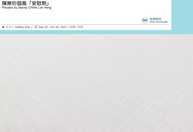Stacey Chan Lok Heng: Placebo 陳樂珩《安慰劑》
|
|
Stacey CHAN Lok Heng 陳樂珩
Placebo《安慰劑》 25 September – 30 October, 2021 Gallery EXIT presents “Placebo”, the first solo exhibition by Stacey Chan Lok Heng. In this exhibition, Chan continues to delve into the material of pharmaceuticals, conferring on it a new form and imagination, so as to explore the meanings and associations of medical cure in terms of individual psychology, beliefs and social customs. The works deconstruct the physical manifestation and inherent symbolism of western pharmaceuticals as a kind of everyday object, reflect on the relationship between contemporary art, medical cure and religion as a commercial item. “Placebo” is Latin for “I shall be pleasing.” In western medical treatment, placebo is adopted as a substitute for medicine and an alternative therapy. While placebo is “any sham medication or procedure designed to be void of any known therapeutic value”, the patients, believing in the therapeutic value of the placebo, psychologically perceive the relief and even cure of the illness. In this exhibition, “placebo” refers to the audience’s expectations of the art exhibition and the artworks. From where she sees it, when the audiences encounter art, they often expect to be “healed” or “redeemed” spiritually, and the artist is often deified. In the past when Western science had not yet become popular, medicine, religion, and art were regarded as one and the same. In Role Playing A Doctor, Chan takes inspiration from the Chinese doctor’s handwritten prescription and creates a series of abstract paintings that resemble scribblings. If Western medicine represented scientific rationality, then handwritten prescriptions are like hand-drawn runes in religious rituals, endowed with a sacred and mysterious power, for those who believe in their healing power shall be healed. Since 2017, Chan has been creating conceptual works that involve the use of pharmaceuticals such as repairing cracks in an empty room with powdered antidepressants, and sculptures in the form of Buddha statue casted by Prozac. Here in this exhibition, the artist applies for the first time this material as a colour pigment in her paintings. The three square pastel paintings are made with powdered pills in different colours applied on the canvas. Delicately and in the most minimal of manners, the works are painted over repeatedly, the gesture of which is not only a repetitive daily practice for the artist, but there is also this sacredness of the religious ritual. Three types of symbols recur in the three paintings: The fence, the cross and the horizontal line, corresponding to the relationship between disease and confinement, healing and religion, medicine and mental state. In Dosage, Chan tries to express a kind of repressed, disoriented yet calm mental state under prolonged use of psychotropic drugs from the perspective of a patient. Redemption II combines religious symbols with pharmaceuticals, by casting the powdered pills, cast into heads of Buddha and sold in bottles. The work raises a question: In the context of modern commercial marketing, are religion and art also commodities? The artist evokes the dual symbolism of the elevation of medical science to the religion of the new era on the one hand, and the degradation of religion into a commercial accessory on the other. In The Placebo, the artist combines the “hand” motif and the form of the pill, creating identical miniature pills in the form of palms, which are arranged neatly together. The relationship between the saviour and the saved exists in the worlds of art, religion and medicine. From her observation of the Buddha’s mudra, the artist associates a variety of extended meanings, such as the Buddha’s mudra representing salvation, the patient’s hand receiving the pills, the waving hand of the drowning man, the gesturing raised hand and the hand signal for “stop”. The Utmost Normality expresses the contemporaries’ obsessive pursuit of the so-called “normality”. Its concept is to provide a kind of medical treatment for “normal people”. The pill is composed of half-stimulant and half-stabiliser, a new medicine product designed to make “normal people” more normal. The work poses a question of what exactly is normal under social expectations and norms. Related Articles:
|











